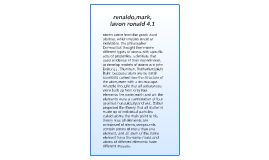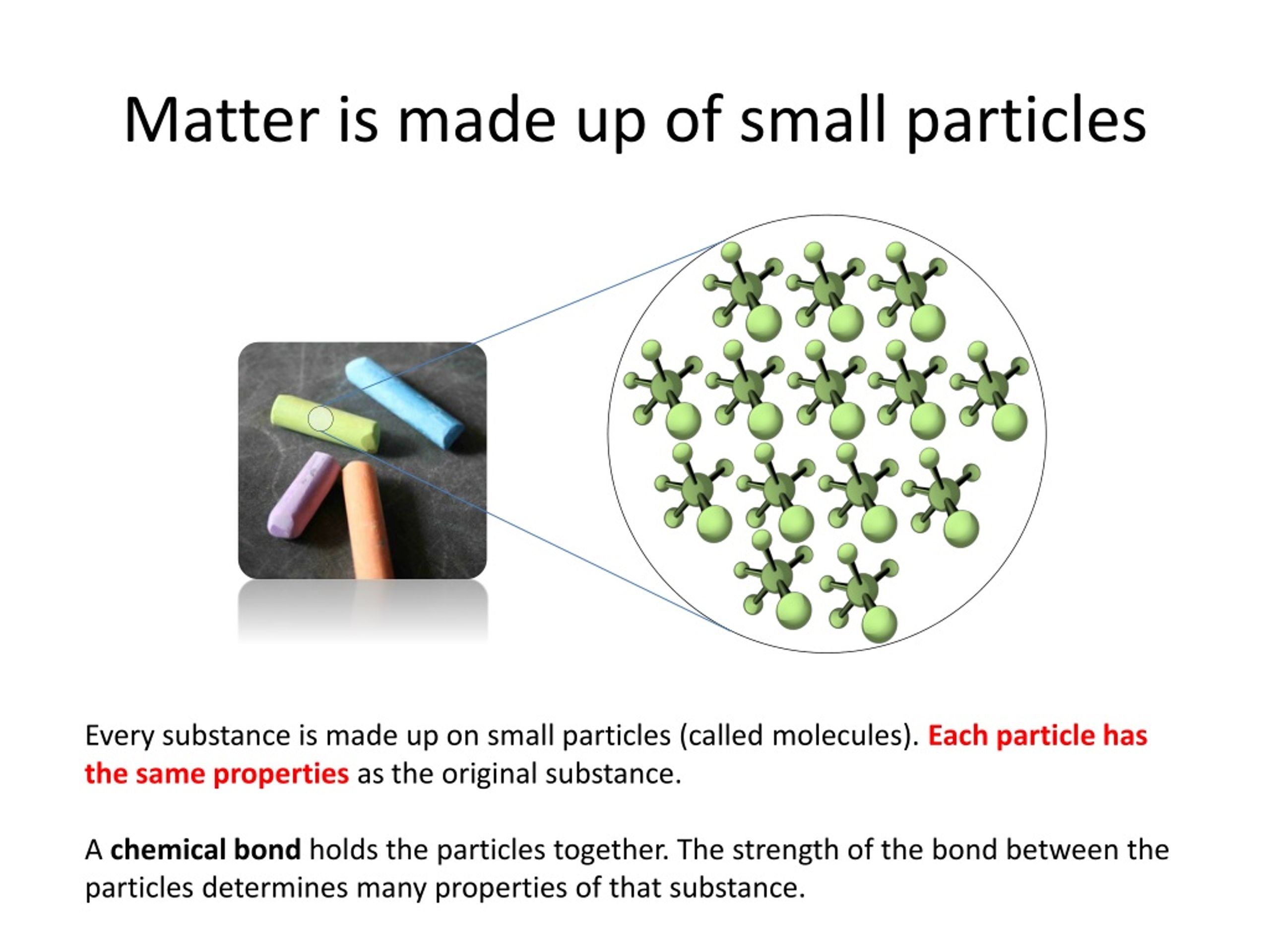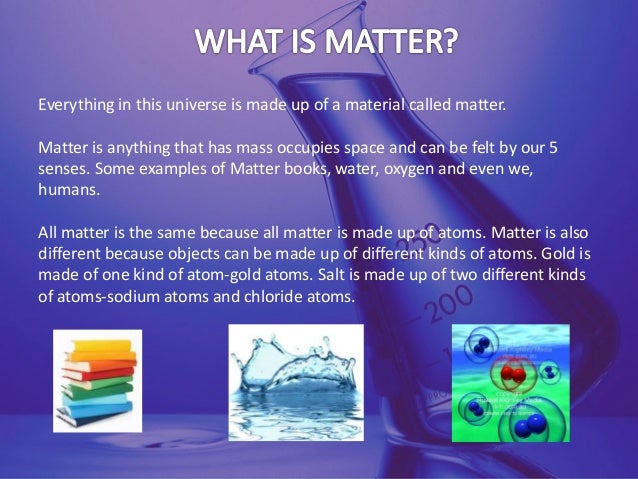Based on protons, neutrons and electrons A definition of 'matter' more fine-scale than the atoms and molecules definition is: matter is made up of what atoms and molecules are made of, meaning anything made of positively charged protons, neutral neutrons, and negatively charged electrons. Beside above, are human cells made up of atoms? As far as you're concerned, all matter is made up of elements. Any object that you can see or touch is going to be made up of elements. That being said, there is plenty of matter in the universe that is NOT made up of elements. Electrons for example. Electrons can be part of an atom, or they can be independent and shot out of an electron gun.
Planets, stars, and other cosmic objects are made up of matter, as are the atoms that exist even in our own bodies. But matter is not all that makes up the universe, and on the cosmic scale it is hard to determine exactly how much is normal matter, and how much is something else.
In a team of scientists from the University of California, Riverside claim they have made the most accurate measurement of the amount of normal matter in the universe — and it is just 31.5 percent.
Idea a: All matter is made up of particles called atoms and molecules (as opposed to being continuous or just including particles). On the following page, the idea is stated as one of four concepts in Dalton's theory: “ All matter is composed of tiny, indivisible particles called atoms” (p. All normal matter is made up of atoms. And Atoms are made up of smaller particles, and so on in to theoretical physics. There is also theorized to be 'dark matter' to which we do not understand.
Their research is detailed in a study published this week in The Astrophysical Journal. The findings could help scientists understand how the universe evolved — and what the rest of it is composed of.
Scientists believe the universe is made up of three things: normal matter, dark matter, and dark energy. Normal matter is the atoms that make up all cosmic objects in the universe, yet it accounts for the smallest proportion of the cosmos.
In fact, most of the universe is made up of dark energy. Dark energy is theorized to make up some 70 percent of the universe, but despite its abundance, dark energy has never been directly observed nor measured.

Dark matter accounts for the rest of the universe. It is the missing mass that holds all matter, galaxies and stars in place through its gravitational force.
Due to the mysterious and, well, dark nature of dark energy and dark matter, it is hard to determine exactly how much of the universe that they account for.
To calculate the amount of normal matter in the universe, the team behind the new study looked at the largest structures of the cosmos — galaxy clusters.
Galaxy clusters consist of hundreds to thousands of galaxies, bound together through gravity. They form from matter that has collapsed over billions of years under the weight of its own gravity, so the number of clusters observed today correlates to the total amount of matter in the universe.
“A higher percentage of matter would result in more clusters,” Mohamed Abdullah, a graduate student at UCR's department of physics and astronomy, and lead author of the new study, said in a statement. “The ‘Goldilocks’ challenge for our team was to measure the number of clusters and then determine which answer was ‘just right.’'
The team behind the new study created a catalog of galaxy clusters, and compared the number of clusters in their catalog to simulations of clusters to determine the total amount of normal matter. By doing so, they calculated the best combined value of normal matter to be at 31.5 percent of the total amount of matter and energy in the universe.
The remaining 68.5 percent is dark energy, according to the study.
Understanding dark energy is crucial to our understanding of the universe. This dark force is responsible for the accelerating rate of the expansion of the universe, pulling galaxies apart with its strong gravitational force.
As scientists get a better idea of the expansion rate of the universe, they will also get better insight at how the universe evolved over time, and where it all began.
Abstract: We derive cosmological constraints on the matter density, , and the amplitude of fluctuations, , using , a catalog of 1800 galaxy clusters we identified in the Sloan Digital Sky Survey-DR13 spectroscopic data set using our GalWeight technique to determine cluster membership. By analyzing a subsample of 756 clusters in a redshift range of 0.045 ≤ z ≤ 0.125 and virial masses of M ≥ 0.8 × 1014 with mean redshift of z = 0.085, we obtain (systematic) and (systematic), with a cluster normalization relation of . There are several unique aspects to our approach: we use the largest spectroscopic data set currently available, and we assign membership using the GalWeight technique, which we have shown to be very effective at simultaneously maximizing the number of bona fide cluster members while minimizing the number of contaminating interlopers. Moreover, rather than employing scaling relations, we calculate cluster masses individually using the virial mass estimator. Since is a low-redshift cluster catalog we do not need to make any assumptions about evolution either in cosmological parameters or in the properties of the clusters themselves. Our constraints on and are consistent and very competitive with those obtained from non-cluster abundance cosmological probes such as cosmic microwave background, baryonic acoustic oscillation (BAO), and supernovae. The joint analysis of our cluster data with Planck18+BAO+Pantheon gives and .
All matter is made up of very small particles called Atoms.
All matter is made up of very small particles called atoms.
It is D
Explanation Scientists knew matter exists, since matter is everywhere. So, when they saw what makes up matter, they discovered atoms.
1 False. Atoms can be divided, see case of radioactive materials
What Is Made Of Matter
Explanation:
Dalton's theory says that matter is made up of very small particles called atoms that are indivisible and cannot be destroyed, chemical compounds are made up of atoms.


With this statement, we can review the proposals,
1 False. Atoms can be divided, see case of radioactive materials
2 True. Chemical reactions are performed by atoms.
3 True. This statement remains unchanged.
All Matter Is Made Up Of Particles Called

4 True. The compound or molecules are formed by atoms
atoms
Explanation:
Matter is made up of very small particles called atoms. Atoms are the basic units of matter and the defining structure of elements.
Hope this helps
The answer is atoms
Explanation: A definition of 'matter' more fine-scale than the atoms and molecules definition is: matter is made up of what atoms and molecules are made of, meaning anything made of positively charged protons, neutral neutrons, and negatively charged electrons.
The given statement on matter is true.
Explanation:The matter refers to any substance or object that occupies volume. A matter always has mass which are composed of huge number of microscopic particles named atoms. The atoms are comprises subatomic particle, however, it does not contain particle like photons (massless particle).
The matter is classified widely based on many factors and based on its existence it is classified as liquid solid, and fluid. Depending on the structure, the matter is classified into baryonic matter, hadronic matter, degenerate matter, and strange matter.
Thus, the matter comprises tiny particles.
All Matter Is Made Up Of Atoms
An atom are the basic building blocks of ordinary matter. Atoms can join to form molecules, which in turn from most of the objects around you.
Atoms are composed of particles called protons, electrons, and neutrons.
Protons carry a positive electrical charge.
Electrons carry a negative electrical charge.
Neutrons carry no electrical charge at all.
Hope i helped! And i know you didn't ask for all that, but i put by the way. If you need anything else ask me.
All Matter Is Made Up Of What
1/0.14nm = 10^10/1.4 a lot
All Matter Is Made Up Of Tiny Particles Called
